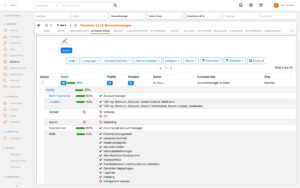It seems there are some obvious unique properties that make Actonomy’s xMP best of breed in the searching technology business. In a series of blogposts, Actonomy’s CEO Filip De Geijter explains the details of these USP’s. After the first one (dealing with flexibility), he now focuses on transparency and the value of transparent matching. In short: both recruiter and candidate get the full advantages of understanding why there is match, or not.
Actonomy’s xMP isn’t a black mystery box
Black boxes: you know what you put in, and what comes out. But what happens in between? No idea! Is this the kind of technology that you trust? Of course, many technology developers dislike the idea of showing transparency in the internal process. Because, after all, when you show how a decision tree is made up, don’t you give the opportunity to your competitors to copy your smart insights?
When we at Actonomy started developing our searching and matching tool xMP Semantic Mind, we decided to go for full transparency. No open source code, of course, but no black box either. Unlike other technologies, xMP gives full insights in the processes that have lead to proposed matches between candidates and jobs. Elementary in this transparency approach is the idea that you want to show why a certain vacancy and a certain job candidate form a perfect match. And why others do not. What skills match which requirements? And what skills are lacking?
As evident this may sound at first, it is not. Competing systems using deep learning techniques (neural networks) only provide output (good matches) but refrain from explaining the why’s and how’s of this match. However, recruiters like to know why candidates and vacancies do or do not match. This insight will be useful when having personal contact with the candidate.
Understanding which elements do or don’t give a match
In an ever more volatile world, the set of demands for particular jobs is steadily increasing: more and more skills are needed for a particular vacancy. On the other hand, job seekers also become ever more demanding: they might look for a job in Sweden, although they do not speak Swedish yet. Learning Swedish might be one of the reasons to apply for a vacancy where knowledge of Swedish is required. In other words: volatile environments do augment the need to understand what elements do and what other elements do not give a match. And also: how strong or how weak these matches are. These insights do provide both the recruiter and the candidate fruitful insights to further elaborate on during a face-to-face interview.
xMP Semantic Mind visualizes all matches between all elements in the vacancy and all elements in the application, and provides a score for every information cluster. The way the scores are calculated are based on Actonomy’s predefined rules, but can also be fine tuned by the recruiter: that is what we call flexibility.
This transparency being truly unique on the market, the question remains: why is transparent matching truly a unique proposition? Firstly, because it creates credibility: technology is fun, but it must be capable of arguing why it does what it does. By explaining why a candidate and a job get a good match, xMP increases the acceptability of the technology by building trust. Second, this transparency provides a powerful tool to the recruiter, as he is capable of dealing with skill gaps, discussing with the candidate and working out solutions for the skill gaps the candidate may have.
In short: transparency provides comfort to both the recruiter and the candidate. This is where automated searching and matching becomes truly exciting!
In our next posts, we will focus on the accuracy and completeness of Actonomy’s xMP.







